Sabirova G. A., Sadikov A. U., Khamrakulova M. A.
Research Institute of Sanitation, Hygiene and Occupational Diseases of the Ministry of Health of the Republic of Uzbekistan, Tashkent
Copyright © 2024 The Author(s). Published by Scientific & Academic Publishing.
This work is licensed under the Creative Commons Attribution International License (CC BY).
http://creativecommons.org/licenses/by/4.0/

Abstract
To clarify some aspects of the mechanism of action of chemical factors under conditions of optimal and high air temperatures and a protein-deficient diet in the dynamics of growth and development of rat pups, we conducted studies of the indicators of the end products of anaerobic glycolysis - pyruvic and lactic acids and tissue respiration and oxidative phosphorylation in liver mitochondria.
Keywords:
Mitochondria, Liver, Tissue respiration, Carbohydrate metabolism, Benzene, High temperature
Cite this paper: Sabirova G. A., Sadikov A. U., Khamrakulova M. A., Features of the Influence of Adverse Factors on the Indicators of Carbohydrate Metabolism, Tissue Respiration and Oxidative Phosphorylation in Liver Mitochondria, American Journal of Medicine and Medical Sciences, Vol. 14 No. 5, 2024, pp. 1208-1215. doi: 10.5923/j.ajmms.20241405.14.
1. Relevance
According to the UN, a third of all diseases registered in the world are directly related to the poor quality of the environment, their 10 most significant causes of morbidity and mortality, most of them are related to environmental influences and of these, at least 6 are related only to the nature and style of nutrition [5,6,13]. All this requires targeted treatment and preventive measures based on scientific evidence in reducing morbidity and preventing most cases of premature death from them [1,3].The relevance of scientific work is determined by the need of medical and hygienic science and practice, its state and intersectoral nature [4,14]. Development of therapeutic and preventive nutrition for patients with occupational diseases based on domestic products, taking into account the characteristics of national cuisine, as well as development against the background of dietary nutrition with specific prevention and treatment with the addition of biologically active substances and special therapy for intoxication with harmful chemicals [8,11].
2. Purpose of the Study
Identification of the mechanism and patterns of action of a complex of physical, biological and physical (protein- insufficient diet, Benzene and high air temperature) on the metabolism of carbohydrate-energy metabolism in the liver of white rats and baby rats.
3. Materials and Methods of Research
Research was carried out to elucidate the possible mechanism of the complex effect of the hydrocarbon Benzene, a protein-deficient diet, optimal and high air temperature on the state of carbohydrate metabolism and tissue respiration and oxidative phosphorylation in the tissues and mitochondria of the liver [2,12].The functional state of liver mitochondria was studied by determining tissue respiration and oxidative phosphorylation of the substrate α-ketoglutaric acid [7].The studies were carried out on 8 groups of white rats - females and pups.Group 1 (control 22°C) - maternal rats during pregnancy, childbirth and lactation received a standard diet of the vivarium and the general diet of the pups from 7 to 30 days were fed breast milk and from 29-31 days switched to the diet of the vivarium in conditions of optimal air temperature; The 2nd group - maternal rats, like the 1st group - received vivarium food in conditions of high air temperature (38.2±2.1°C); Group 3 - maternal rats during pregnancy, after birth and lactation were on a protein-deficient diet at a temperature of 38°C. After birth, the pups received mother's milk for 20-25 days, after the end of lactation they switched to a protein-deficient diet for 90 days at optimal temperatures. Group 4 - maternal rats during pregnancy, childbirth and lactation received a protein-deficient diet (the rats were then slaughtered) and after the birth of the rats they received mother's milk and after the end of lactation they received a protein-deficient diet until the end of the experiment in conditions of high air temperature. Group 5 - maternal rats during pregnancy, after birth and during lactation received Benzene intragastrically at a dose of 1/50 LD 50 (LD 50 - 5600 mg/kg) body weight and were kept at optimal temperature until the end of lactation. After birth, the pups were suckled on mother's milk and after feeding they switched to standard vivarium food and were intragastrically administered Benzene for 90 days under conditions of optimal air temperature. Group 6 - rats during pregnancy, childbirth and lactation and with intragastric administration of Benzene at a dose of 112 mg/kg - were on vivarium food, white rat pups after birth were on breast milk and then switched to vivarium food and received Benzene intragastrically for 90 days of exposure to high temperature conditions. Group 7 – maternal rats during pregnancy, childbirth and lactation using protein-deficient food and intragastric administration of Benzene for 30 days (after which they were slaughtered to study carbohydrate metabolism, tissue respiration and oxidative phosphorylation ). After birth, the pups received breast milk until 25-30 days and then switched to a protein-deficient diet under conditions of optimal air temperature with intragastric administration of Benzene for 30 days in rats and from 29 to 90 days in rats. Group 8 – maternal rats during pregnancy and lactation were on a protein-deficient diet with exposure to Benzene for 30 days; at the end, after exposure to all factors, they were slaughtered for research. After birth, the pups and young animals were fed milk (until the 30th day) and after (30th day) the young animals switched to a general protein-deficient diet with the introduction of Benzene in conditions of high air temperature.The content of the end products of anaerobic glycolysis - pyruvic and lactic acids in the liver tissues and the intensity of respiration and oxidative phosphorylation in the liver mitochondria of rats and rat pups by differential centrifugation.After the end of the experiments (maternal rats on day 30, pups were suckled on mother’s milk for 30 days and then switched to the vivarium diet (1-2 control groups received the standard vivarium diet and experimental groups received protein-deficient food (groups 3 and 4) under conditions of high and optimal air temperature, groups (7 and 8) were on a diet of protein-deficient food + Benzene under conditions of optimal and high air temperature.The slaughter of rats and rat pups (after the 30th day of the experiment) was carried out at each age by decapitation of the animals.Experiments were carried out on white rats (during pregnancy, childbirth and lactation), as well as on rat pups at each stage of growth (7, 15 days of breastfeeding) - from 30-32 to 90 days - under the influence of factors.mM EDTA, 10 mM as isolation medium tris HC l, pH-7.4. The parameters of respiration and oxidative phosphorylation were determined by the polarographic method (POLOGRAF - LP -9) in a medium of the following composition: sucrose 0.25 mM, K •H 2 PO 3, pH-7.4, α- ketoglutarate 5 mM. The reaction was started by adding a mitochondrial suspension to the cell.The rate of oxygen consumption by mitochondria in various metabolic states ( V 2 - before adding ATP, V 3 - after adding ADP; V 4 - after depletion of ADP and recording with a polarographic rotating platinum electrode at a temperature of 25°C. α-ketoglutaric acid was used as an oxidation substrate (8 mm).
4. Research Results
Changes in the parameters of pyruvic and lactic acids in liver tissue under the influence of Benzene and a protein-deficient diet under conditions of optimal air temperature (22°C) are shown in Table 1.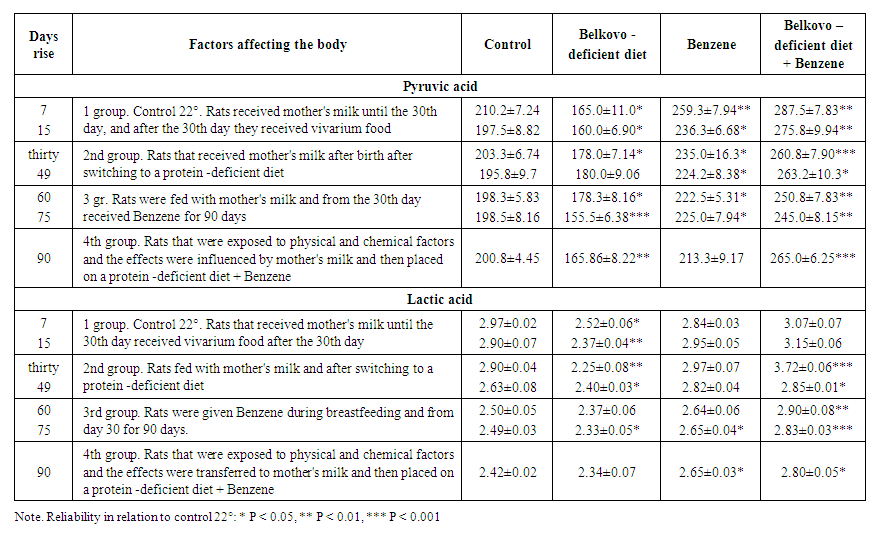 | Table 1. The content of pyruvate and lactate in the liver tissue of rat pups at different ages under the influence of unfavorable factors ( protein -deficient diet and their mixtures) under conditions of optimal air temperature |
As can be seen from the table, the content of pyruvic acid in the liver tissue of white rat pups of the control group at an air temperature of 22°C was at a level from 195.8 to 210.2 µmol /g.In group 1, when animals were given a protein-deficient diet at an air temperature of 22°C, the level of pyruvic acid in the liver decreased relative to the control at 22°C. On the 7th and 15th day of age in rat pups, the amount of pyruvic acid decreased compared to the control to 79 and 81%, respectively.. During the remaining periods of animal growth, the amount of keto acid decreased by 30, 45, 60, 75 and 90 days, respectively, to 88, 92, 90, 79, 83%.The content of lactic acid in the liver tissue of rat pups of the control groups, located at an air temperature of 22°C, differed little from each other and ranged from 2.42 ± 0.02 to 2.63 ± 0.08 mmol / g.In animals of group 2, which did not receive a complete protein diet during breastfeeding and the 30th day, the content of lactic acid in conditions of high and optimal air temperature in the initial period of breastfeeding (until the 30th day) decreased significantly (during the remaining periods of the study the changes were within physiological fluctuations).With repeated exposure to Benzene at an air temperature of 22°C, the concentration of lactic acid in the liver differed little from the control group.When exposed to Benzene against the background of a protein-deficient diet of animals and during breastfeeding in both temperature conditions (22 and 38°C) in the initial - postnatal period of growth, the concentration of lactic acid tended to increase, and starting from the 45th day of age its level increases significantly.It should be noted that when Benzene was administered under optimal temperature conditions, the level of lactic acid in the liver tissue increased slightly to 101-110%. In the control group, during the period of breastfeeding and feeding the rat pups with a protein-deficient diet, the content of lactic acid (LA) significantly decreased at all stages of growth of the pups.Summarizing the above, we can conclude that when exposed to Benzene, there is a disturbance in carbohydrate metabolism in the liver of rat pups under conditions of optimal air temperature.A particularly sharp disruption of anaerobic glycolysis and redox processes is observed in the initial period of body growth (30-45 days of life). The greatest changes in biochemical processes are observed at high air temperatures.Consequently, with chronic exposure to the pesticide, glycogenolysis, glycolysis and inhibition of the oxidative breakdown of pyruvic acid in the liver tissue are enhanced.More profound disturbances in the amount of the final product of anaerobic glycolysis were observed when rat pups were fed a protein-deficient diet (group 2 at temperatures of 22° and 38°C), which is confirmed by a decrease in the concentration of pyruvic and lactic acids, which indicate a decrease in metabolic power (especially at high temperatures air) in the body of animals. It is possible to reduce the use of keto acid for the synthesis of one’s own protein to compensate for protein deficiency in the body.Thus, unfavorable chemical, physical and biological factors cause disturbances in the metabolism of carbohydrate metabolism, which negatively affect the growth and development of rat pups, especially in the early postnatal period.When studying the content of pyruvic acid in liver tissue when using a vivarium food ration under conditions of high air temperature in control groups of 38°C, the level of pyruvate was 250.2±5.13, 243.3 during breastfeeding (7-15 days). ±10.5 and after switching to the vivarium diet – 244.2±8.2 – 230.0±8.1 µmol /g. So, when compared with the control (22°C) at high temperature, this indicator increased significantly.Data on the content of carbohydrate metabolism metabolites in rat pups on a protein-deficient diet (group 2), exposed to chemical and physical factors under conditions of high air temperature, are presented in Table 2.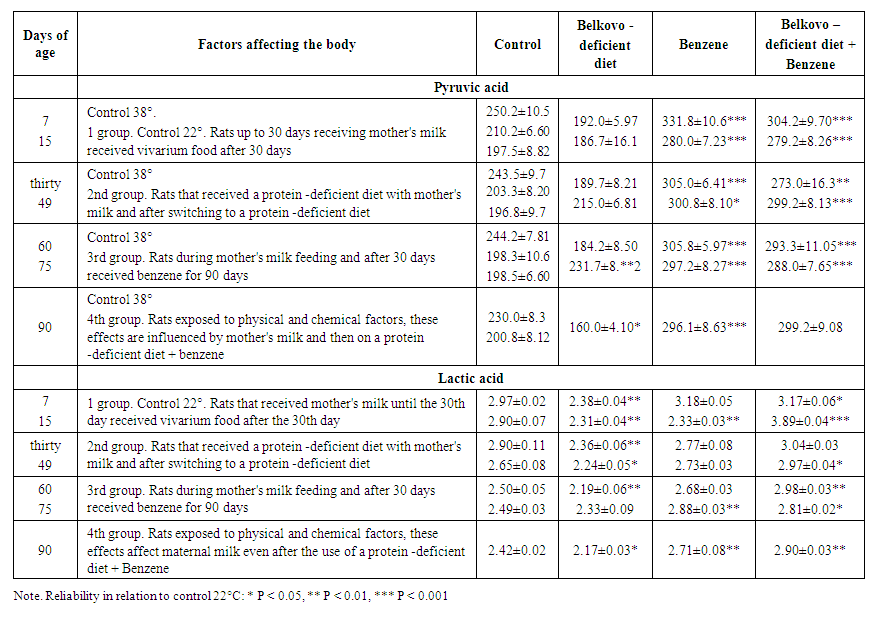 | Table 2. The content of pyruvate and lactate in the liver tissue of rat pups at different ages under the influence of unfavorable factors ( protein -deficient diet, Benzene and their mixtures) in conditions of high air temperature |
The table shows that in rat pups fed a protein-deficient diet under conditions of high air temperature, the content of pyruvic acid on the 7th, 15th, 30th day of growth showed a tendency to decrease (85-91%), and on the 75th day there was a slight increase, which indicates a metabolic disorder of protein metabolism (Table 2).When intoxicated with Benzene (group 3) under conditions of high air temperature, a sharp increase in the concentration of pyruvic acid is observed at all stages of growth of the rat pups. The above makes it possible to believe that high temperature aggravates the effect of Benzene on the metabolites of carbohydrate metabolism in the body of rat pups.With repeated administration of Benzene against the background of a protein -deficient diet on the body of rat pups at a temperature of 38°C, the increase was much more pronounced than at a temperature of 22°C. The above makes it possible to believe that air temperature aggravates the effect of an aromatic hydrocarbon and the insufficiency of a protein product in the diet nutrition on the metabolism of carbohydrates in the body of white rat pups.Similar changes in the amount of pyruvic acid occur with a protein -deficient diet under conditions of high air temperature, but these changes are less pronounced than at optimal air temperature (Table 2).The data obtained on protein deficiency in the diet indicate the possibility of using pyruvic acid in the metabolism for the synthesis of proteins of non-essential amino acids (alanine), which leads to a decrease in this keto acid.A study of the content of pyruvic acid in the liver of rat pups when fed with mother's milk revealed that its level when exposed to Benzene at an air temperature of 22°C on the 7th and 15th days of age significantly increased (up to 123, 120%), in other periods (after 90 days of exposure Benzene at a dose of 112 mg/kg) age increase is not significant (up to 106-116%).With repeated exposure to Benzene against the background of a protein -deficient diet on the body of rat pups at optimal air temperature, the content of pyruvic acid in the liver tissue on the 7th, 15th, 30th, 45th, 60th, 75th and 90th days of age increased (to 137, 140, 128, respectively). 134, 126, 145 and 132%) (Table 1, group 4).A study of the intensity of tissue respiration and oxidative phosphorylation in liver mitochondria under the influence of Benzene under conditions of optimal air temperature and insufficient protein diet is presented in Table 3.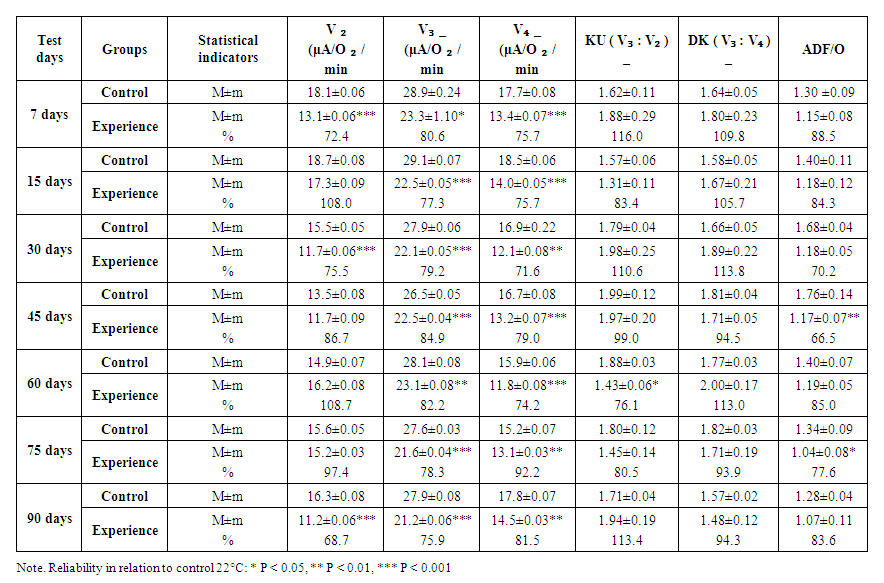 | Table 3. The influence of Benzene under conditions of optimal (22°) air temperature with a lack of protein diet on the intensity oxidative phosphorylation of α-ketoglutaric acid in liver mitochondria in rats of different ages |
The intensity of tissue respiration and oxidative phosphorylation in liver mitochondria was determined by adding an endogenous substrate, which was α-ketoglutaric acid.Determination of tissue respiration and oxidative phosphorylation with this substrate was carried out in rat pups in the period after birth, which were suckled by mother's milk and after the 30th day they were administered Benzene at a dose of 112 mg/kg (1/50 LD 50 ) for 105 days under conditions optimal air temperature.Rate of liver mitochondria with the addition of the substrate α-ketoglutaric acid (V2) during hydrocarbon poisoning (Benzene) at an air temperature of 22°C at all stages of growth of rat pups decreased to 68.7-97.1%. And the rate of phosphorylation of ADP (V3) was inhibited to 75.9-89.9%. The respiration rate of liver mitochondria after depletion of ADP μAO 2 /min (V4) decreased to 71.6-92.2%.In these leads (V2; V3; V4) with intragastric administration of Benzene with insufficient feeding of rat pups with protein during all periods of the study, the indicators of respiration rate and oxidative phosphorylation in mitochondria decreased under conditions of optimal air temperature in relation to the control group (22°C).The value of respiratory control (RC) when exposed to Benzene with insufficient protein in the diet during breastfeeding on the 7th day decreased slightly and on the remaining days (6-75 days) also decreased to 90.0-93.0%, in the remaining periods of the experiment were at the level of the control group.The ratio of ADP to oxygen consumed (ADP/O) during all periods of growth of young rat pups at all periods of the study decreased at a temperature of 22°C.When studying the dynamics of the rate of respiration intensity and oxidative phosphorylation in liver mitochondria under the influence of an aromatic hydrocarbon - Benzene against the background of insufficiency of proteins in the diet at a temperature of 38°C, inhibition of the intensity of the V 2 process was observed; V3 and V4 at all times of the experiments using the substrate α-ketoglutaric acid. A particularly sharp decrease was found at a temperature of 38°C, at which on the 60-90th day of exposure to factors, V2 indicators; V3 and V4 decreased to 61.3-84.0% (Table 4).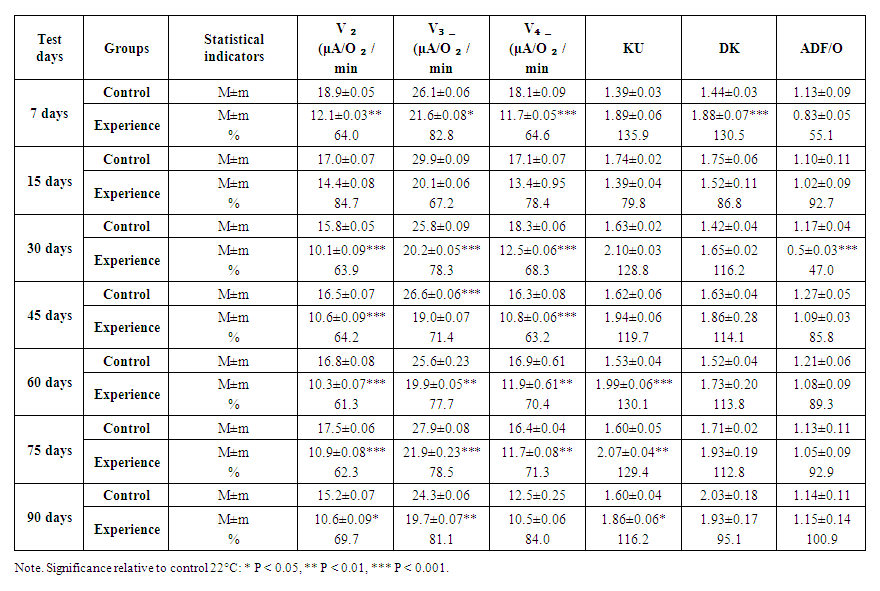 | Table 4. The influence of Benzene in conditions of high air temperature (38°) with a lack of protein diet on the intensity oxidative phosphorylation of α-ketoglutaric acid in liver mitochondria in rats of different ages |
Reduced during all periods of the experiment, these processes are especially pronounced under high temperature conditions.Based on the studies conducted, it can be considered that when young rat pups were poisoned with Benzene, who were on a protein-deficient diet, it had an inhibitory effect on the processes of respiration and oxidative phosphorylation in liver mitochondria. Under conditions of high air temperature, the factors have a pronounced slowdown in the speed of the above processes.When studying the intensity of tissue respiration and oxidative phosphorylation when exposed to Benzene during all periods of growth (after the birth of rat pups, Benzene was supplied with the mother's milk of poisoned rats after suckling with mother's milk and properties during Benzene poisoning under conditions of optimal air temperature). It was found that in leads V 2 ; V 3 and V 4 in liver mitochondria are inhibited when using α-ketoglutaric acid. Indicators of the respiratory factor have a disproportionate state and the state of ADP/O to consumed oxygen decreased to 69.8-72.7% at a temperature of 22°C (Table 5).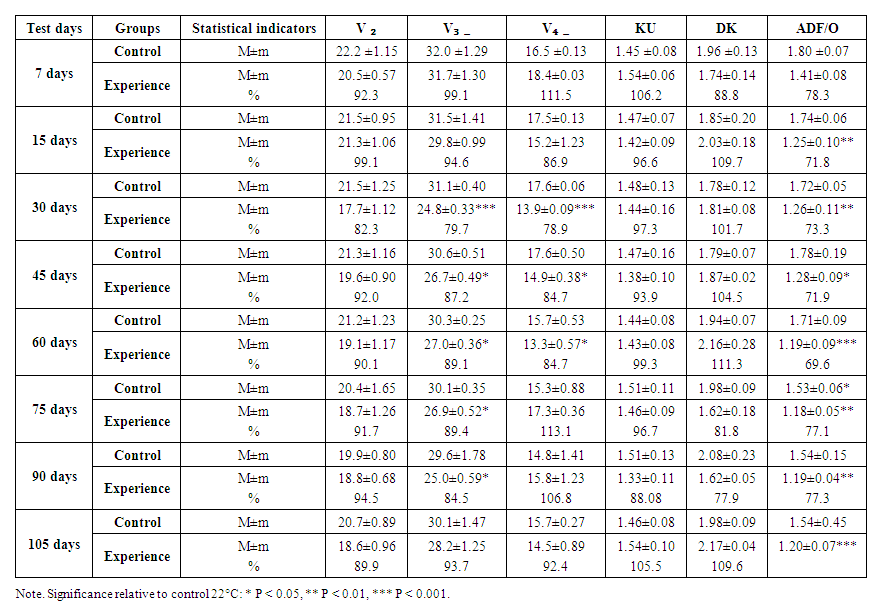 | Table 5. Effect of Benzene on the intensity of oxidative phosphorylation in liver mitochondria of rats of different ages at optimal air temperature (22°) |
With repeated administration of Benzene to rat pups during 105 days of growth (maternal rats received hydrocarbon intragastrically during pregnancy and lactation), after birth the pups took mother's milk.When studying the intensity of tissue respiration and oxidative phosphorylation in liver mitochondria under the influence of Benzene and using the exogenous substrate α-ketoglutaric acid, a sharp inhibition of V2 indicators was revealed; V3 and V 4, as well as the ADP/O ratio in liver mitochondria at all stages of rat growth under conditions of high air temperature (Table 6).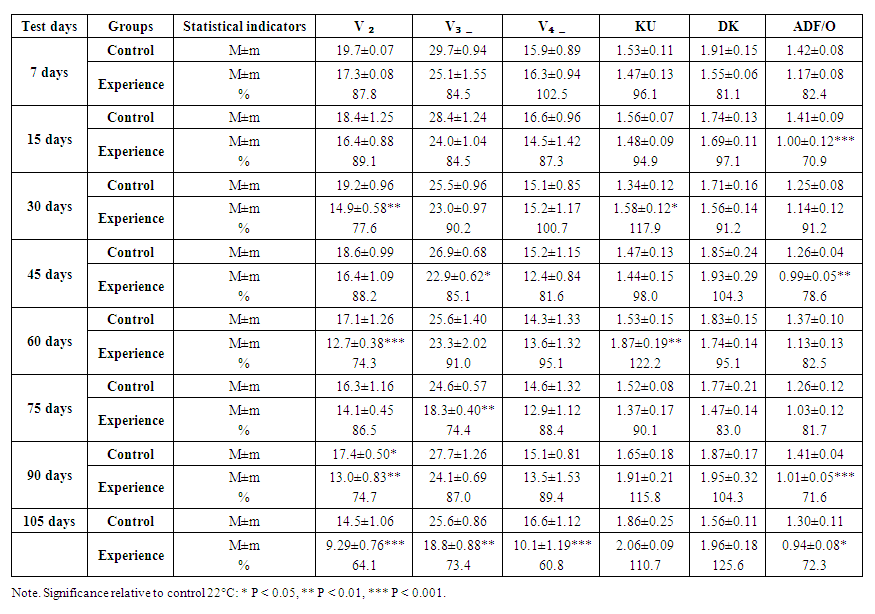 | Table 6. The influence of chemical (Benzene) physical factors (high temperature (38°) on the intensity of oxidative phosphorylation in liver mitochondria of rats of different ages |
The data obtained suggest that when exposed to Benzene, changes in the amount of exogenous substrates against the background of shifts in respiration activity and oxidative phosphorylation of the substrate α-ketoglutaric acid in liver mitochondria under conditions of high air temperature were quite sharply reduced.The results of a study of tissue respiration and oxidative phosphorylation in liver mitochondria under the influence of Benzene in animals of different ages showed that a significant suppression of energy metabolism was observed during Benzene poisoning. Consequently, high air temperature aggravates the effect of Benzene on the intensity of oxidative phosphorylation in liver mitochondria during different periods of growth of rat pups.A sharp suppression of the intensity of tissue respiration and oxidative phosphorylation in rat liver mitochondria was observed in animals fed a protein -deficient diet. It follows that a decrease in the level of enzymatic activity of liver tissue was observed under the influence of chemical, physical factors and a protein -deficient diet during certain periods of ontogenesis and may be associated primarily with a decrease in the synthesis of catabolic proteins and inhibition of the activity of the process.
5. Conclusions
1. When studying the respiration of liver mitochondria in the presence of the substrate α-ketoglutaric acid, significant pronounced changes were found in the intensity of respiration, oxidative phosphorylation of the substrate α-ketoglutaric acid in liver mitochondria when exposed to Benzene at an air temperature of 22°C.2. Based on the data obtained as a result of experimental studies, the following can be stated: high ambient temperature, Benzene and insufficient protein diet significantly slow down the activity of respiration and oxidative phosphorylation, and with the combined influence of the above factors they cause a potentiating effect on the growth and development of the animal body.
References
| [1] | Akalaev R. N. et al. Toxic liver damage in acute poisoning and endogenous intoxication (literature review) // Bulletin of emergency medicine. – 2020. – T. 13. – No. 6. – pp. 95-102. |
| [2] | Alimbabaeva N. T., Khalitova R. A., Mirkhamidova P. M., Tutundzhan A. A. Effect of karate on lipid peroxidation in mitochondria and microsomes of rat liver // Uzb. biological _ magazine. – Tashkent, 2005. - No. 6. -WITH. 34-37. |
| [3] | Baturin A.K., Pogozheva A.V., Martinchik A.N., Safronova A.M., Keshabyants E.E., Denisova N.N. and others. Study of the nutritional characteristics of the population of the European and Asian parts of the Arctic zone of Russia // Questions of nutrition. 2016. T. 85, No. S2. P. 83. |
| [4] | Bakhtiarov D. The best recipes of Uzbek cuisine // Tashkent. 2002. –480 p. |
| [5] | Wang Wei C.W., Ayerton -Jones K. Secrets of nutrition / Trans. from English _ –M. – St. Petersburg: “Publishing house BINOM” - “Publishing house “Dialect”, 2006, 320 p. |
| [6] | Gurvich M.M. Diet for diseases of the digestive system. – M.: GEOTAR-Media, 2006. – 287 p. |
| [7] | Ibragimova F.I., Sadikov A.U., Ilyasova M.M. Some issues of the influence of sodium hypochlorite on the metabolism of carbohydrate-energy metabolism // Human physiology: materials of the All-Russian correspondence scientific conference with international participation / ed. D. A. Dimitrieva, E. V. Saperova. – Cheboksary: Chuvash. state ped. univ., 2016. – pp. 91-95. |
| [8] | Kobelkova I.V., Baturin A.K. Analysis of the diet of persons working with sources of ionizing radiation at enterprises in Moscow and the Moscow region // Issues. nutrition. 2010. T. 79, No. 1. pp. 40-45. |
| [9] | Kuzmenko S. B., Kuzmenko E. V. Central Asian and Transcaucasian cuisines // Moscow. 2002, 784 p. |
| [10] | Martinchik A.N., Maev I.V., Yanushevich O.O. General nutrition. –M.: MEDpress-inform, 2005. -392 p. |
| [11] | Orudzhev R. A., Jafarova R. E. Features of the toxic effect of petroleum hydrocarbons on the human body // Bulletin of Vitebsk State Medical University. – 2017. – T. 16. – No. 4. – pp. 8-15. |
| [12] | Rakhmetova A.M. and others. The influence of professional production factors of rubber production on the functional state of the digestive organs // Bulletin of the Kazakh National Medical University. – 2019. – No. 2. – pp. 130-133. |
| [13] | Shtenberg A.I., Okrakova Yu.I. "Guide to practical exercises in food hygiene", 1996. |
| [14] | Shaikhova G.I., Rakhimov B.B. Hygienic justification of diets for obesity. T. 2010, 7-9 p. |




 Abstract
Abstract Reference
Reference Full-Text PDF
Full-Text PDF Full-text HTML
Full-text HTML


